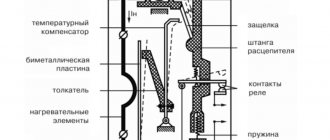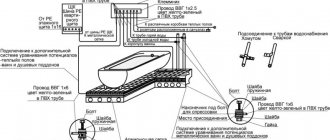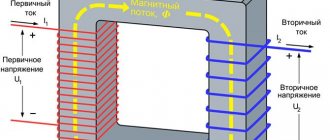Due to the improvement in the technical equipment of attackers, hacking or entering any premises today is only a matter of time, which in such situations is not on the side of the owner. To prevent unauthorized intervention, security alarms are now widely used as an effective means of preventing theft or reducing the extent of its consequences. How the alarm system works and what principles to follow when choosing it we will look at in this article.
Compound
A security alarm is a component of a complex of security systems designed to provide notification in the event of a violation of private property. The effectiveness of the system directly depends on the ability to assess penetration factors and transmit information about it. In accordance with clause 4.1. GOST R 52435-2015 the alarm system includes:
- Notification modules;
- Reception and control unit;
- Alert modules;
- Alarm control devices.
Rice. 1. Composition of a security alarm
Notification module
The notification module is a system of sensors that respond to changes in the parameter they measure (sound, movement, temperature, pressure, circuit integrity, etc.).
Rice. 2. Sensors for security alarms
Based on the principle of operation and purpose, there are a huge number of different categories of sensors, but the most commonly used sensors in security alarm systems are:
- Openings - a magnetic key/lock, one half of which is installed on the frame, and the second on the doors or window. When the latter are opened, the magnetic key moves away from the lock and opens the way for the signal to flow.
- Movements - perceive information about the state of the entire volume of premises and give a signal if there is any movement in space.
- Glass breakers – can be mounted both directly on glass and nearby. Most of these models respond to high- and low-frequency sound vibrations and vibration.
- Thermal - react to temperature fluctuations in space, since the temperature of the human body differs significantly from the environment.
If a sufficient level of the measured value occurs, the sensor converts it into an electrical signal, which is then transmitted via communication lines.
Reception and control unit
The receiving and control unit is used to take readings coming from sensor circuits. It collects and processes the received information and, if the signal data matches, it launches an alarm and notification algorithm. Typically, this unit contains an electronic controller programmed to operate on a number of incoming and outgoing communication lines.
Alert modules
Alert modules are designed to report intrusion or perimeter violation. To do this, they can transmit data to law enforcement agencies, security companies, display it or use other methods of influence. By type they are divided into the following types:
- Sound sirens are dynamic or piezoelectric sirens. Designed to scare intruders, cause panic and force them to leave the territory.
- Light - similar to the previous ones, but they have light effects. Depending on the method of influence, they can blink or simply turn on the light, simulating the movement of guards around the territory.
- Combined - combine sound and light methods of influence, are considered more effective due to increasing psychological stress in offenders.
- Telephone – transmit information via communication lines in the form of a recording to security organizations or an authorized department.
- Mobile – notify the owner and other structures about the incident via SMS notification.
- Telecontrol – provides data about an incident to a remote control or mnemonic panel.
In practice, not one, but several options are installed at once, which is why several data transmission channels are output from the receiving and control unit at once. In some security alarm models, logic can be set by priority or depending on influencing factors.
Control device
Security alarm control devices allow you to set an operating mode, activate or disable sensors, open doors or give a green light in certain situations.
For this purpose the following can be used:
- Keyboard with display – installed at checkpoints, indoors. Allows you to operate the security alarm by entering codes and commands.
Rice. 3. Keyboard with display
- A portable remote control or key fob allows you to change the configuration of work processes or interact with the security alarm in the friend or foe mode.
- The key is an original version of access through the system into the premises, into the territory of the facility. Cards, key tablets and other devices are used as keys.
Rice. 4. Using a tablet key
System composition
The security alarm system consists of the following components:
- Central control device
- Executive controller
- Remote Control
- End devices (sensors)
- Notification devices (siren, display panels, etc.)
- Cable infrastructure
There are also many options by type of execution, from small home systems to industrial or automotive ones. According to the principle of operation, the systems can be loop-type (analog) and addressable (there are also addressable-analogue ones, but they are used mainly in fire alarm systems).
- Loop or analog alarm systems work by constructing a linear topology of security loops, which include analog sensors and a mandatory end-of-line resistor. Executive controllers are responsible for organizing security loops (in the particular case of small systems, this function is performed by the central controller). The security loop has restrictions on the maximum length and the number of sensors included in it (depending on the executive controller), just as the main communication bus with the central controller must have a linear topology and has a limitation on the maximum permissible length and the number of executive controllers on it (depending from the central controller). The advantages
of loop systems: they work on a regular RS485 interface, they are cheaper, you can use analog sensors from any manufacturer.
Cons
: If the loop is damaged, all the equipment on it fails; if there are many sensors of the same type in the loop, then if one malfunctions, you will have to check everything. - Addressable alarm systems operate on a ring loop topology, which includes addressable sensors and, when triggered, the sensor not only transmits an alarm to the central controller, but also its location (address). In addition, the ring topology allows the equipment to operate even if the loop is damaged (the damaged area is isolated). Likewise, if a sensor malfunctions, you know its exact location. In addition, in addressable systems, the device polling time is shorter (again due to the ring topology), and a loop can include a larger number of addressable sensors than an analog one. Disadvantages
: you will have to select central equipment and sensors from the same manufacturer, since there is no uniform operating protocol between addressable systems from different manufacturers; addressable equipment, in principle, is more expensive than analog equipment. - In hybrid addressable-analog systems, non-addressable sensors can be connected to the addressable executive controller through special addressable modules. This principle is often used when creating fire alarm systems.
It must be said that there are quite a lot of manufacturers of control devices and sensors in Russia; this is a very developing area. The largest of them are: RUBEZH Saratov, BOLID Moscow, SIGMA-IS Moscow, Radium JSC, VERS, Siberian Arsenal. Home alarm systems: Guardian (PS-Link company), Ajax, IPRo-gsm, Mirage-gsm (Stealth NPP company) and others.
Principle of operation
Let's simulate a situation when some movement occurs in a protected space. The motion sensor will detect movement in the coverage area and send a signal via communication lines to the receiving and control unit. Here the received data will be processed and sent via loops to the executive body. The warning module will begin to turn on the lighting in the area and start a siren or strobe light.
Fig.5. The principle of operation of the security alarm
If the security alarm is connected to the security post or is displayed on the police console to the duty officer, then the data will be sent via the mobile channel to the authorized structures. In addition, information can be transmitted to the owner’s mobile phone through an SMS alert system or through a specialized mobile application.
The security alarm can be turned off using a separate button or by entering a special command code to stop. The system is triggered in a similar way by any other type of notification module.
Lots of smart hacking methods
Knowing about the methods listed above, the main unit began to be protected from third-party influences. Now a spark discharge can burn the antenna module, but the alarm will remain unharmed. And the use of a shocker will not lead to anything: there is a galvanic isolation in the load circuit connected to the signaling device. Therefore, intelligent methods are now more often used to disarm a car without damaging the equipment.
Relay – element of galvanic isolation
One of the smart methods (using the Valet button) was discussed in the previous chapter. Let's talk about the rest.
Application of a scanner, comparison with a grabber
In the early 90s, hacking car alarms did not cause any problems. It was enough to buy a key fob suitable for a particular signaling device and go through the code values. There were few values, and they were set using switches located on the key fob. To speed up the search, they came up with a device called a scanner. This device broadcasts all codes sequentially (the starting value is “000...”). The scanner hacked any security device that perceived its signal as a key fob code.
This is not a key fob, but a scanner
Engineers managed to find out exactly how the hack is carried out. They invented a protection: having received a false code, the signaling switched on the standby mode for 2-3 seconds. Using a scanner, such devices cannot be hacked (it will take a day or two to search). And then code grabbers appeared, allowing you to “read” the signal emitted by a “real” key fob. Serious security devices have a cyclic set of codes. But this protection is often bypassed.
Let's say a person approaches your car and is standing close to the body at the moment the alarm is disarmed. Then, there is no need to wait for the locks to operate. In this case, it is better to release the key fob button and move away from the car.
The attacker is close to the car
At a minimum, a person strives to find out what kind of alarm system you have installed. Why spread unnecessary information? It is not necessary.
Alarm with cyclic dialing of codes
When studying an alarm device released in the 90s or 2000s, you can notice the following. Inside each additional key fob there is only a transmitter, but no radio receiver. They could not deviate from this principle for a very long time. Two-way communication appeared in signaling systems not so long ago.
One way communication circuit
Let a one-way connection be established with the main unit. Suppose the key fob stores not one code, but many (500-1000). These codes can be used cyclically, and the signal should store a similar array. The check performed before opening the locks in this case looks like this:
- The key fob sends a code stitched into its memory under number N.
- The signal receives the correct value, and the counter in the block moves to code N+1. The value of code number N is now perceived as false.
- The locks are activated.
- In the key fob, the counter value also increases by 1.
Someday the sequence of codes will reach the last one. Then, in steps 2 and 4, the key fob, as well as the alarm, will “reset” their counter (the value will become “1”).
When step 2 is performed, the alarm considers not only code N to be correct, but also several subsequent codes. What is provided so that it is possible to disarm the car if the UNLOCK button is pressed outside the range of the unit.
UNLOCK button circled
Pressing it multiple times causes the system to stop accepting “its” key fob. This drawback is irremovable. Therefore, they usually provide for the possibility of emergency recovery of the key fob. Otherwise, the considered scheme would look absurd.
An alarm of this type cannot be disarmed if you do not know which code was used last time.
The key fob stores this information in memory. Let's say a certain subject is standing next to the car when the button is opened. Then there is reason to suspect something is wrong. When carrying out emergency recovery of key fobs, you also need to make sure that there are no strangers nearby. By the way, immobilizers of modern cars identify the key according to the principle discussed in this chapter.
Conversational code becomes a panacea
The connection between the key fob and the main unit can be two-way. This opens up more opportunities to increase the strength of protection.
The key fob and the alarm are in dialogue
In short, it looks like this: the main unit sends a random number over the air, which is encrypted by the key fob chip and sent back to the signal. The signaling unit performs decryption, and then compares the two numbers received and sent. If they do not match, it will not be possible to disarm the car.
The algorithm that was considered was called dialogue code. Such a code cannot be cracked by a grabber: the correct value is updated every time, and reading it will be useless. Perhaps, in the case of using dialogue systems, the attacker has one option - to use emergency disarming. But setting a personal code solves this problem too.
Not everyone understands the intricacies of modern car electronics. Therefore, they strive to hack the alarm system, and not to disable it. This leaves the option to use the standard immobilizer bypass.
Immobilizer bypass – alarm element
No one will try to remove the terminals from the battery either. This makes no sense, since the alarm has a built-in battery.
Let's say the attacker was unable to hack using any of the methods considered. Then, they do it simpler - turn on the GPS navigator jammer, jam the GSM signal and take the car away on a tow truck. For reliability, to shield all radio waves, a van is used instead of a tow truck. Draw conclusions.
Types
Security alarms are developed and implemented according to certain templates of technical specifications. The implementation of solutions to certain problems is carried out through systems of a certain type. Depending on the criterion, several types are distinguished; thus, according to the method of influence, there are two types:
- Active - have a direct impact on robbers by attracting security, alerting law enforcement agencies, and other methods of influence.
Rice. 6. Active type of security alarm
- Passive - create a number of effects designed to scare away intruders. This includes light, sound and other impacts that occur within protected objects.
Depending on the type of communication lines through which information about an incident is transmitted, there are two large categories - wired and wireless models.
Wired systems are divided into:
- Analog - transmit information through a loop over a wire to a specific notification point. They are a cheap, but uninformative system.
- Addressable - has an assigned address for each object, the information is processed by a microprocessor and transmits a signal about a specific sensor to the operator.
Wireless security alarms can also be divided into several groups, depending on the transmission channels:
- By radio signal - uses radio transmission devices to send an alarm signal, can be done with or without feedback;
- Via mobile channels – uses modems with classic or specialized SIM cards;
Rice. 7. Mobile transmission
- Via Wi-Fi signal – uses Internet resources to send alarm protocols.
No. 4. GSM alarm system for home
A security alarm system that transmits information to owners and a security company via cellular networks is one of the most modern and optimal options for organizing the protection of your own home. A separate or built-in GSM module is equipped with a SIM card from one of the operators , with the help of which information is transmitted. It is recommended to use two SIM cards from different operators to ensure maximum system reliability and stability.
In case of penetration into an apartment, information about what happened is transmitted to the owner, security structure and other trusted persons, and the data can be broadcast in the form of SMS, MMS with a photo or a call . Sirens and flashing lights may be activated along with the information being sent.
A security alarm of this kind may include a panic button . This is a kind of sensor, but it is triggered if a person presses it. If you are in an apartment and feel something is wrong, you just need to press a button for the security service to arrive (when a remote alarm is used).
GSM alarms are often enhanced with video cameras and microphones to visualize what is happening. Sometimes they include sensors for gas leaks and water leaks, but this is no longer a security alarm in its pure form. Signaling capabilities through the use of cellular communications are significantly expanded, but at the same time the cost of the system increases, dependence on the quality of services of the cellular operator, and if you want to maximize the quality of the system, you will have to resort to the services of a dispatcher.
If the apartment uses a “smart home” system, then a security alarm can be built on its basis. You can increase the level of security by connecting a TV or music center to the alarm system, which will turn on periodically and simulate the presence of people in the apartment.
Security alarm features
Before choosing a specific model, it is important to determine the main characteristics of the protected object. Namely, you must inspect the premises or territory to identify the most likely points of entry, points of storage of valuables, documents, etc. Determine where the control unit will be installed, the distance to the sensors and source elements, and whether communication will be established with the dispatch console.
For a private home.
In a private home, it is important to install both wired and wireless security alarm systems. It is important to note that control is established both inside the house and outside: at the entrance, near the gate, along the perimeter of the fence, etc. Along with classic security modules, the “smart home” option is gaining popularity today, which also provides the ability to control the open/closed position of windows and doors, program the reaction of sensors to movement in rooms, and much more. It also allows video surveillance of both individual rooms and the surrounding area.
For an apartment.
Depending on the size of the apartment, the area of the rooms and the number of windows, you can install a passive system that responds immediately throughout the entire home or an active system that transmits burglary data to the control panel. It is desirable that the security alarm monitors all rooms without exception; the coverage also includes loggias, balconies, storage rooms and other components through which penetration is possible. For small areas, you can use autonomous alarms that work only inside the apartment.
For the dacha.
The main difficulty of a summer cottage is its remoteness from the owner and, possibly, from a populated area, which significantly complicates the process of going to the site and actively responding. Therefore, a passive security alarm system that outputs data via a GSM channel to the owner’s phone is relevant for a dacha. It is also important to trigger light and sound alarms to scare away intruders.
For the office.
Rice. 8. Organization of an alarm system in the office
If the premises for an office are rented, then using a wired security alarm system is not practical; it is much more profitable to install devices that operate via wi-fi or a radio signal. In office settings, a video surveillance system is a good help, which, in addition to security functions, will help monitor the work of employees. Depending on the assigned tasks, the security alarm can have both active and passive versions. For example, in small buildings with departmental security or a watchman, a sounding siren will be enough to attract their attention.
Types of security sensors
Reed switch
This two-component magnetic contact sensor is used everywhere to protect doors and windows from burglary. It consists of two parts, one of which is installed on the fixed part of the protected structure (reed sensor), and the other on the moving part (magnet); when closed, these parts are in contact. While the door is closed, the magnet acts on the reed switch and keeps the contacts inside it in a closed state; when the door is opened, the magnetic field disappears and the reed switch contacts open. All parts of the sensor are isolated and sealed in sealed housings; they are not affected by the environment, they are noise-resistant and durable. Manufacturers of sensors type IO102: Magneto-contact, Komplektstroyservis.
Infrared optical-electronic detectors
They are divided into two large groups - active
and
passive
.
According to the detection zone, detectors are volumetric
(passive type of operation) and
linear
(active type of operation).
The principle of operation of a passive volumetric detector
is that background thermal radiation from nearby objects hits the Fresnel lens inside the sensor, which cuts the detection zone into sectors, and the sensor is triggered by the temperature difference between these sectors.
Despite the fact that these sensors are quite sensitive, have a wide detection zone and sensitivity settings, they can be deceived. Sensors of this type react to convection radiation from heating devices; they will also give an alarm to illumination by sunlight; in addition, any obstacle is opaque to them and will affect detection; such a sensor can be deceived, for example, by moving very slowly in its detection zone and bringing your temperature closer to the temperature environment (foil). Manufacturers of sensors such as Photon, IO-409: Rielta, Teko, Sibirsky Arsenal, Crow, Argus-Spectrum. Linear active detectors
consist of an IR emitter and a receiver (thus they are active). The design of such detectors can be in the form of two blocks or a combination of emitter and receiver in one block, in this case a reflector is used to reflect the infrared beam of the detector. The range of action of such linear sensors can reach up to hundreds of meters, but the setup of the entire system requires very precise adjustment. Such sensors are used to protect the perimeter, block doorways or corridors; some models use not one beam, but two or three, to increase the vertical detection zone. A special case of linear IR sensors are fire detectors for detecting smoke in large rooms. The operating principle of photoelectric sensors is similar, but instead of IR rays, rays of the visible spectrum are used. Manufacturers of SPEC type sensors: SPEC, Poliservis, Optex, Ademco.
Acoustic sensors
The principle of their operation is that inside the sensor there is a microphone, a filter of certain frequencies and a chip that processes the received signal; if the sensor is active, then it contains a sound wave emitter of a certain frequency and a reflected wave receiver.
Infrasonic detectors
react to low frequencies (below 20 Hz), these sound waves are weakly absorbed by various media and can travel over long distances, thus, one sensor can cover a large detection area, for example, an entire apartment or several adjacent rooms. The source of infrasonic waves can be explosions, distant impacts, ground transport, earthquakes, construction tools (for example, if someone is digging at depth). Often, the analysis of infrasound waves is combined with other sensors, for example, in vibration-acoustic sensors.
Ultrasonic active detectors
are an emitter and receiver of high-frequency waves that are inaudible to humans (15 kHz - 75 kHz). Ultrasound is reflected from hard surfaces (walls, ceilings, floors, furniture) and absorbed by soft surfaces (human body, upholstered furniture). The sensor responds to the displacement of an ultrasonic wave by an object in the detection field of the sensor (Doppler effect), this is one of the types of motion sensors.
Glass break sensors
react to a sound audible to a person and similar to cotton, or a gunshot, or breaking glass. The most common type of acoustic sensors is used to protect window openings. Manufacturers of IO-329 type sensors: Rielta, Teko, Bolid, Sibirsky Arsenal.
Microwave sensors
These sensors use microwaves to detect an object. The operating principle is similar to an ultrasonic motion sensor. A microwave source and receiver are connected in one housing; the sensor responds to the Doppler shift of the reflected wave as an object moves through the sensor detection zone. Microwaves are also blocked by hard surfaces. Often multiple technologies are used in a single motion sensor to improve detection efficiency, such as microwaves and IR, ultrasound and IR. There are barrier microwave sensors, separated into two blocks - a microwave source and a receiver. Manufacturers: Hikvision, Optex, Crow, Teko, GSN
Fire sensors
These are all kinds of smoke, heat, and open fire detectors. The simplest thermal
sensors, which are essentially thermal relays, respond to a threshold temperature value (approximately 70C), for which the sensor is programmed at the factory.
Another option is an integrated thermal sensor that responds to a sharp increase in temperature per unit time. However, their efficiency is quite low, since for large rooms, for the air temperature to warm up to such temperatures, the fire must already be quite serious. Their use is justified in warehouses, where a fire will be accompanied by a large release of thermal energy. Smoke
detectors work in much the same way, the sensor detects smoke particles in a chamber that has infrared radiation inside, and active infrared detectors work in a similar way.
The downside is that such sensors react to steam and dust; it is not recommended to install them in objects with high humidity or construction sites. Flame sensors
react to open fire; they are often used in industrial premises, since such a sensor can react when there is not yet a lot of smoke and, especially, high ambient temperatures. The downside is that the sensors also react to sun glare or headlight flashes, for example, on glass. In addition to the usual design for wired systems (these are analogue, addressable and combined fire detectors), there are fire detectors (and everyone has seen them in new buildings) for home use - for example, the simplest smoke detectors with a siren, powered by batteries. When such a sensor detects smoke, the siren turns on and screams. This is a completely autonomous design; the alarm signal does not go anywhere except the surrounding space. In more advanced houses, such sensors are combined not only with a siren, but also with a control device installed in the entrance, to which at least a smoke removal system is sewn, which turns on forced ventilation in the shafts and stops the elevator. The alarm signal, again, reaches the control device and this is where its path ends. For smart home systems, sensors are made that operate via radio or WiFi from low-current power or batteries. Such sensors are integrated with the controller responsible for the “smart home” and the user receives alarms through a cloud service or application.
Fire detectors cannot be included in the same loop as security ones.
Vibration sensors
The operating principle of a vibration sensor is based on a change in the electrical signal passing through a piezoelectric element when the sensor vibrates. These are detectors of the “Rustle”, “Udar”, “Astra” types. Used to protect storage facilities, safes, walls (floors, ceilings) from undermining, penetration and destruction. Manufacturers of IO-313 type sensors: Rielta, Bolid, Sibirsky Arsenal, Optex.
Panic buttons
These are manual call points used to transmit an alarm signal to the user of the system. An alarm (like a fire) plume has a special type; it can be either armed or in alarm. Panic buttons can be wall-mounted (desktop) or in the form of a wearable radio button (SOS button in a car that transmits an alarm signal via a GSM channel). Such devices are used in banks, at security posts of objects, where increased protection is required. It is clear that when the panic button is pressed, the alarm signal must go somewhere else other than the control device, therefore at such facilities there is a security agreement with private security companies or federal state unitary enterprises. Panic buttons also cannot be included in the same loop with security sensors.
Other sensors
There are a great variety of them. Passive magnetometric systems for protecting perimeters record changes in the magnetic field when moving near cars, intruders with weapons, and other ferromagnetic objects. Electrostatic motion sensors, the principle of which is to measure variations in the dielectric constant of the medium using the capacitive method (for example, the “Gyurza” sensor). Electric fences for perimeter security and other systems for detecting physical perimeter intrusion.
Nuances of installation and assembly
Modern security alarm units can be easily installed by yourself, but some rules and nuances should be taken into account:
- If you install motion sensors, then you should take into account that in accordance with paragraphs 2.2.7 - 2.2.9 of GOST 26342-84, these devices have a gradation based on the volume of the room and the speed of movement of a person. Which you should consider when setting up protection.
- When choosing a wireless alarm, keep in mind that the coverage distance of the sensors depends on their technical parameters.
- When installing equipment outdoors, take into account the temperature conditions of your region, otherwise the security alarm may stop working at extremely low temperatures.
- If power surges occur, be sure to install a battery for uninterrupted operation.
- The fewer sensors you install, the less security alarm coverage and functionality you will have.
- Do not skimp on components; your safety and the safety of your property depend on their quality.
How alarms have been hacked before
We don’t want the car to start squealing after opening the door and trying to start the engine. This means you will need to bite off the wires going to the speaker. At one time, this is what they did, and there was another method in use. It was possible to disable the signaling itself, for which an electric discharge was used. The turn signal was broken and the corresponding plug was installed in the socket, to which the shocker was connected. A spark discharge produced near the receiving module also disables the alarm system.
A high-voltage arrester is a useful thing
If you are not friendly with electricity, no problem. Use emergency disabling of the security mode. While in the cabin, you need to press the Valet button in a certain sequence, and then the specified mode is deactivated. If, when setting up the alarm, the owner does not set a personal code, the “unlocking sequence” will be used standard, suitable for all models of the same company. Emergency disarming is an excellent method of theft. It is suitable for any cars.
What to choose?
On the modern security alarm market there is a fairly large range of products from a variety of manufacturers. Therefore, next we will consider the most reliable and proven companies that operate on the market:
- Jablotron is a world-class manufacturer producing the latest security alarm equipment;
- Visonic Ltd is an Israeli manufacturer of security alarms that has held a leading position in the market for about half a century;
- SATEL is a Polish concern whose products are characterized by affordable prices and acceptable quality;
- Sapsan is a domestic manufacturer of security alarms; the devices are reasonably priced and well adapted to our conditions;
- Ajax is a relatively new company that has already proven itself to be the best in the market.
List of used literature
When writing this article, the following textbooks were actively used:
- O. M. Lepeshkin, V. V. Kopytov, A. P. Zhuk “Integrated security means and technical means of fire alarm systems” 2009
- Vorona V.A., Tikhonov V.A. "Technical security and fire alarm systems" 2018
- G.M. Punegov “Secrets of installing security systems” 2017
- Biryukova O.V. "Electronic alarm systems" 2015
- Gruba I.I. “Security alarm systems. Technical means of detection" 2012
Notification system. Divided into three types: light, sound and combined
These devices, in cases of danger, draw attention to the object. These include sirens and strobe lights.
Communication modules
Communication modules are designed to connect system components with each other, as well as to connect the control panel with the monitoring center. The devices use radio channels, wired channels, telephone lines, GSM channels and the Internet for communication.
Power supply modules
The alarm system components are powered using uninterruptible power supplies; they provide long-term backup of common power lines. Wireless alarm sensors are usually powered by batteries or rechargeable batteries. To increase the operating life of devices without replacing batteries (by more than a year), you need to use energy-saving components. The advantage of the security alarm system is that it monitors the state of the power supply and its components, and in case of failures or errors notifies the user and the monitoring center.
Security systems greatly ruin the lives of various categories of unscrupulous citizens, so we strongly recommend installing them, whenever possible, on all of your real estate.











